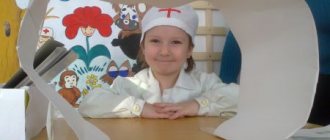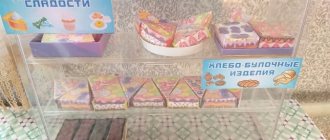Summary of a role-playing game in the junior group “Hospital”
Bibliographic description:
Trufanova, M. Yu. Summary of the role-playing game in the junior group “Hospital” / M. Yu. Trufanova, T. L. Tarasova, E. S. Shevtsova. — Text: direct // Questions of preschool pedagogy. — 2022. — No. 9 (36). — P. 119-121. — URL: https://moluch.ru/th/1/archive/179/5663/ (access date: 01/13/2022).
Goal: To develop in children the ability to take on a role and perform appropriate game actions.
Tasks:
Educational : to develop in children the ability to take on a playing role (doctor’s assistant, doctor, patient). Encourage children to play out the plot of the familiar game “Hospital”, using familiar medical instruments (toys);
Developmental: develop children’s speech, interaction skills with each other;
Educational: to cultivate a caring attitude towards one’s health, the ability to show sensitivity and care for a sick person.
Methodological support: Katya doll , children's set “Hospital” (thermometer, syringe, phonendoscope, bandage, cotton wool, etc.); chairs for patients; gowns for doctors and nurses; recipes.
Preliminary work: excursion to a medical office to observe the work of a nurse in a kindergarten; conversations on the topic: “Going to the doctor at the clinic”, etc., examination of illustrations: “Hospital”, “Pharmacy”; reading fiction: K. Chukovsky “Aibolit, V. Suteev “About the hippopotamus who was afraid of vaccinations”;
didactic games: “Who is this?” , “Who needs what,” “What does it do?” , creating and playing game and problem situations; teaching game techniques.
Vocabulary work: thermometer, temperature, vitamins, pills, treats.
Move.
- Org moment.
Educator: In the morning the kids got up,
Everyone came to kindergarten.
We are glad to see you, as always.
We've had guests here since morning,
Say hello friends!
(Children greet guests.)
Educator: Let's wish our guests good morning. And let this wish be warm and joyful.
(soundtrack of a baby crying)
- Motivational and orientation stage.
Educator: Oh, someone is crying.
Yes, this is our Katenka. Hello Katya. (Children say hello to the doll).
Educator. What happend to you?
Educator. Katya told me in my ear that she had a fever, a sore throat and a cough.
- Search stage.
Educator. Guys, can we help Katya? How?
Children . We will take her to the hospital to see a doctor and he will cure her.
- Practical stage.
Educator. Then let's go to the hospital.
Educator. Well, here we are at the hospital.
- Now I will be a doctor and put on a white coat. And you guys will help me see the sick. (Children sit on chairs).
Educator. Let's take Katya's temperature. What will we take?
Children: Thermometer.
Educator. Come on Katya, we'll get you a thermometer.
— Help Olya, put a thermometer on Katya. (The child puts a thermometer on the doll.)
- Olya, look, Katya’s temperature is high?
Child. Yes.
Educator. Now let's look at Katya's neck.
- What will we take for this?
Children . A stick.
Educator. That's right, this stick is called a medical spatula.
- Look, Vanya is Katya’s neck.
- Does Katya have a red throat?
Child. Yes.
Educator. What else should the doctor do?
Children. listen to Katya.
Educator. How will we listen to Katya's breathing?
Children. A tube, a listening ear.
Educator. The tube is correctly called a phonendoscope.
(the teacher invites the child to listen to the doll).
Child. "Breath! Do not breath".
Educator. Is breathing free, without wheezing?
Child . Yes.
Educator. In order for Katya to recover faster, she needs to gargle, drink tea with raspberries, boiled milk with honey, and Katya also needs to be put to bed and covered with a blanket.
- Tanya, give Katya tea with raspberries and put her to bed.
Educator. And now Masha will be the doctor, I will help put on her robe.
And I will be a nurse and will help the doctor. (The teacher acts as an observer and, if necessary, helps correct the children’s play actions)
-Who wants to be a patient? (Choose a patient).
Educator. Doctor say hello and ask what the patient’s pain is.
Doctor . Hello, what hurts you?
Child. Hello, my hand hurts.
Educator. Doctor, look what's wrong with your hand.
Doctor: Let's see, it's a big wound, we need to wash it and bandage it.
Educator. Now we will process it well, like this. And we'll make a bandage. Get well. Goodbye.
Educator. Who's next to see the doctor? Please pass.
Doctor, ask what the patient is complaining about?
Doctor. Tell me exactly where your pain is concentrated?
Patient. I have a headache.
Doctor. Let's see (the doctor examines the patient, takes the temperature, looks at the throat, listens to him).
Educator. The temperature is normal, the breath is clear, the doctor will prescribe the patient a medicine for headaches, he will buy it at the pharmacy.
Educator. So our doctor cured the sick. Doctor, look to see if our Katya’s fever has subsided. (The doctor takes the temperature)
Doctor. No temperature.
Educator. Our Katya has recovered and says thank you to us.
- Reflective-evaluative stage.
Educator. Guys, what game did we play?
Children. Doctor.
Educator. Did you enjoy playing this game?
Children. Yes
What tools does the doctor have?
Children. Spatula, phonendoscope, thermometer.
Educator. Guys, doctors help both adults and children to be healthy. I also liked playing with you. We will play this game after sleep. And now we will say goodbye to Katya and wish her health and say goodbye to our guests. (Children say goodbye to the doll and guests, leave the group)
Program "Algorithms for preschoolers"
The subject-development environment corresponds to the interests and needs of children, the goals and objectives of the additional general education program.
Requirements for an additional education teacher implementing the program
.
A teacher of additional education must know: priority directions for the development of the educational system of the Russian Federation; laws and other regulatory legal acts regulating educational activities; Convention on the Rights of the Child; developmental and special pedagogy and psychology; physiology, hygiene; the specifics of the development of interests and needs of students, pupils, the basis of their creative activity; methods of searching and supporting young talents; content of the curriculum, methodology and organization of additional education for children in health, sports, and leisure activities; training programs for clubs, sections, studios, club associations; activities of children's groups, organizations and associations; modern pedagogical technologies for productive, differentiated, developmental education, implementation of a competency-based approach; methods of persuasion, argumentation of one’s position, establishing contact with students, pupils, children of different ages, their parents, persons replacing them, work colleagues; technologies for diagnosing the causes of conflict situations, their prevention and resolution; technologies of pedagogical diagnostics; basics of working with a personal computer (word processors, spreadsheets), email and browsers, multimedia equipment; internal labor regulations of an educational institution; labor protection and fire safety rules.
Qualification Requirements
.
Higher vocational education or secondary vocational education in a field corresponding to the profile of a circle, section, studio, club or other children's association without presenting work experience requirements, or higher vocational education or secondary vocational education and additional vocational education in the direction of "Education and Pedagogy" without presenting work experience requirements. Organization of a developing subject-spatial environment.
The subject-spatial environment of a preschool institution provides:
— maximum realization of the educational potential of the organization space and materials, equipment and inventory for the development of preschool children;
— the opportunity for communication and joint activities between children and adults;
— provides playful, educational, research and creative activity for all categories of pupils. Experimenting with materials available to children;





